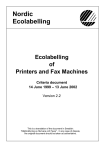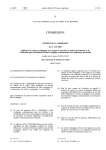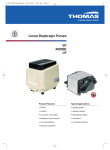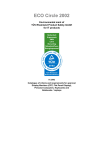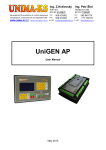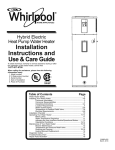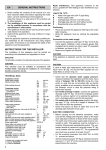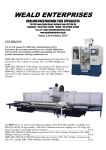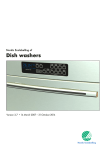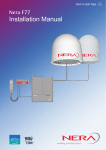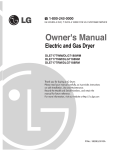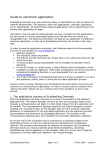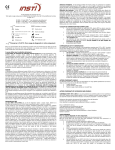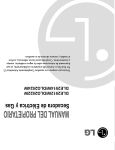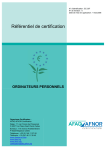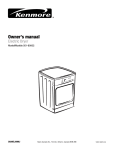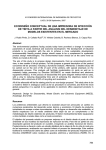Download Nordic Ecolabelling Ecolabelling of Copying Machines, Printers, Fax
Transcript
Nordic Ecolabelling Ecolabelling of Copying Machines, Printers, Fax Machines and Multifunctional Devices Criteria document 6 June 2001 – 9. June 2005 Version 3.0 This is a translation of the criteria document in Norwegian. In any case of dispute, the original document should be taken as authoriative Joint Nordic ecolabelling In November 1989, the Nordic Council of Ministers adopted a measure to implement a voluntary, positive ecolabelling scheme in the Nordic countries. The scheme is administered by the Nordic Ecolabelling Board. The board among other things choose product groups and lay down the final criteria. Secretariates in the participating countries are responsible for implementing the scheme on national level. The objective of ecolabelling is to provide information to consumers to enable them to select products that are the least harmful to the environment. Ecolabelling is intended to stimulate environmental concern in product development and a sustainable society. In its work on ecolabelling Nordic Ecolabelling follows the ISO 14024 standard: "Environmental labels and declarations - Type 1 ecolabelling - Principles and Procedures". The product groups and environmental and performance requirements selected by Nordic Ecolabelling reflect the objectives, principles, practices and requirements of the standard. ISO 14024 includes the requirements that criteria should be objective, reasonable and verifiable, that interested parties should be given the opportunity to participate and that their comments are evaluated. The criteria are based on evaluation of the environmental impacts during the actual products’ life cycle. The criteria set requirements towards a number of these factors. Upon approved application all products found to meet the criteria are awarded the environmental label. Due to new knowledge and production methods the criteria must be updated regularly. New revised criteria are presented at least 1 year prior to the expiry date. During the period of validity minor corrections may be adopted. This will normally not affect already approved licences. A handling fee is paid upon submission of a complete application. The turnover value of the product determines the additional annual fee. Denmark: Ecolabelling Denmark Gladsaxe Møllevej 15 DK-2860 SØBORG tel: +45 39 69 35 36 fax: +45 39 69 21 22 Homepage: www.ecolabel.dk Finland: Iceland: SFS-Miljömärkning Pb 116 FIN-00241 HELSINKI Ministry of Environment Pb 8080 IS-128 REYKJAVIK Tel: +358 9 1499 331 Fax: +358 9 1499 3320 Homepage: www.sfs.fi/ymparist Tel: +354 585 1000 Fax: +354 585 1010 Norway: Sweden: Ecolabelling Norway Kr. Augusts gt. 5 NO-0164 OSLO SIS Ecolabelling SE-118 80 STOCKHOLM Tel: +47 22 36 57 40 Fax: +47 22 36 07 29 Homepage: www.ecolabel.no Tel: +46 8 555 24 00 Fax: +46 8 555 24 88 Homepage: www.svanen.nu Nordic Ecolabelling of Copiers, Printers, Fax machines and Multifunctional machines 015/3.0, 6 June 2001 1 2 3 4 5 6 7 8 9 10 11 INTRODUCTION 1 DEFINITION/LIMITATION OF THE PRODUCT GROUP 2 2.1 Copying machines 2 2.2 Printers 2 2.3 Telefax machines 2 2.4 Printer/fax combinations 2 2.5 Multifunction machines 2 2.6 Extra equipment 2 APPLICATION 3 REQUIREMENTS AS REGARDS THE ENVIRONMENT 3 4.1 Requirements as regards energy consumption 3 4.2 Requirements as regards design 3 4.3 Materials 4 4.4 Requirements as regards toners and ink 6 4.5 Requiremets as regards batteries 7 4.6 Requiremets as regards emmisions 7 4.7 Requirements as regards noise 8 4.8 Requirements as to chemicals used during production 9 4.9 Requirements as to packaging 9 4.10 Recycling requirements 10 4.11 Requirements as to information to consumers 11 4.12 Supply of spare parts 12 REQUIREMENTS AS REGARD EFFICIENCY/FUNCTIONING 12 5.1 Requirements as to duplex function 12 5.3 Requirements as to electrical safety and electromagnetic compatibility 12 OTHER REQUIREMENTS 13 6.1 The requirements of the authorities as to safety, working environment and the external environment 13 6.2 Eco and quality assurance 13 6.3 Marketing 13 ANALYSIS AND CONTROL 14 7.1 Choice of test laboratory 14 7.2 Subsequent inspections 14 REGISTRATION 15 THE DESIGN OF THE ECOLABEL 15 THE VALIDITY OF THE CRITERIA DOCUMENT 15 FUTURE CRITERIA 16 Appendix 1 A reference to Energy Star requirements for copiers, printers and fax machines, multifunctional devices 2 Certificate on the requirements for design 3 Certificate on the requirements for materials I 4 Certificate on the requirements for materials II 5 Certificate on the requirements for the use of chemicals in manufacture 6 Certificate on the requirements for packaging 7 Test method for dust concentration (RAL-UZ) 8 Test method for ozone concentration (RAL-UZ) 9 Test method for styrene concentration (RAL-UZ) 10 Test method for ozone emissions and dust emissions 11 Calculation of ventilation requirements for office machines 12 Certificate on the requirements for duplex copies 13 The marketing of the ecolabelled products for which a licence is sought Nordic Ecolabelling Copiers, printers, fax and multifunctional machines 015/3.0 6 June 2001 1 Page 1 (16) Introduction Nordic environmental labelling criteria for copying machines, printers, telefax machines or combinations of these are being set up in order to promote a reduction of energy consumption, reduction of the number of material types and amounts, reduction of the use of environmentally hazardous substances, as well as longer service life and improved durability and recyclability of products. It has also been considered important to define requirements for good properties in use, such as a low noise level and safety in use. The main environmental impact of copying machines, printers, telefax machines and multifunctional machines occurs during their use and waste phases. The chief environmental problem associated with these machines is high energy consumption. A further important environmental impact is their consumption of paper. Large quantities of waste are generated when products of this nature come to the end of their life cycle. The authorities and suppliers have injected extensive resources into finding systems for processing this waste. Waste is also generated as a result of the replacement of parts that wear out, e.g. combined toner cartridges. Other environmental impacts are associated with the use of dangerous substances in the products such as flame retardants, heavy metals and plasticizers in plastics. Emissions of these substances largely take the form of leakages from waste disposal sites or through emissions to air in connection with incineration. The product group may also represent a source of pollution in the working environment through the generation of heat, emissions to air and noise. The energy consumption of office machines varies considerably and it is likely that a further reduction in energy consumption will be achieved in the future. Many machines are now able to print out on both sides of the paper and to reduce several pages onto a single sheet. If such functions are made available to the user and are used when appropriate, they will serve to reduce the environmental impact of copying and printing considerably. A wide variety of additives are used in plastics in machines available on the market and the environmental impact represented by these additives also varies considerably. Correct design and structure reduce environmental impact in the waste phase and in the machines and there is considerable scope for environmental approvement here. The requirement that manufacturers must utilize reused or 100% recycled plastic parts will stimulate further environmental improvements in the waste phase. There are major differences in the level of emissions into the working environment from the various office machines available. Overall there is considerable potential for environmental improvements within this product group. When buying office machines consumers are faced with many technical specifications. Nevertheless ecolabelling still represents a useful means of guiding product development in the right direction not only for the consumer but also and perhaps more importantly for public sector purchasers. Furthermore, by choosing the ecolabel the customer will often achieve reduced energy consumption, paper costs and a better working environment. This document may only be reproduced in its entirety, and with no modifications of any kind. Excerpts may be used provided that the Nordic Ecolabelling is cited as a source. Page 2 (16) 2 Nordic Ecolabelling Copiers, printers, fax machines and multifunctional machines 015/3.0 6 June 2001 Definition/limitation of the product group The product group in this document encompasses copying machines, printers, telefax machines or combinations of these. The machines may be equipped with external or internal scanners. 2.1 Copying machines A commercially available image reproducing unit, the function of which is to produce a duplicate of a graphic original paper copy. The copying machine must as a minimum contain a system for inking paper, an image projecting system and a paper handling unit. 2.2 Printers A commercially available image or text reproducing unit for printing out on paper from single user or network linked computers. The printers encompassed by the criteria may be based on various print technologies, such as laser/LED, ink jet or matrix technology. 2.3 Telefax machines A commercially available image reproducing unit, the function of which is to transmit or receive information. The machine must be capable of producing a duplicate of a graphic original paper copy that has been transferred over the telecoms network. Similarly, the machine must be capable of transmitting data from a graphic original to other equivalent equipment via the telecoms network. The telefax machines encompassed by the product group may be based on various types of print technology, such as laser, LED, ink jet, matrix or thermal technology. 2.4 Printer/fax combinations A commercially available image reproducing unit which in every respect functions in the same way as a printer (see definition) and telefax machine (see definition). 2.5 Multifunction machines A physically integrated unit or combination of functionally integrated components, the primary function of which is to copy (see definition), but which is also capable of producing paper print-outs (see definition) or of receiving and sending telefaxes (see definition). 2.6 Extra equipment The above products also include various consumer durables, such as OPC kits, drums, toner powder and residual toner cartridges. If extra equipment such as desks, sorters, feeder and external scanners are to be included, the individual parts must meet the requirements as to design, materials, chemical requirements during production, requirements as to packaging and requirements as to recycling. This document may only be reproduced in its entirety, and with no modifications of any kind. Excerpts may be used provided that the Nordic Ecolabelling is cited as a source. Nordic Ecolabelling Copiers, printers, fax and multifunctional machines 015/3.0 6 June 2001 3 Page 3 (16) Application Application for a licence must be accompanied by the documentation specified in each individual requirement in Chapters 4, 5 and 6. The application must contain an outline specifying the documentation submitted for each individual requirement. All criteria described in the document must be fulfilled before a product will be awarded an ecolabel. 4 Requirements as regards the environment 4.1 Requirements as regards energy consumption The energy consumption of the product shall comply with the Energy Star standard, Environmental Protection Agency, USA, applicable at the time an applicant applies the product. Energy consumption must be measured in accordance with the requirements described in the criteria for Energy Star, EPA, USA, see Appendix 1. Documentation A licence document for Energy Star alternatively a report on the result of testing must be attached to the application. 4.2 Requirements as regards design Criteria for copying machines, printers, fax machines and multifunctional devices are related to modular units. A module is a part that can be separated from the product and treated as a complete entity for the purposes of recycling. A modular structure facilitates disassembly as well as making repairs easier. The following requirements have to be fulfilled: - - - - Modules must be easily removable. It must be possible for qualified personnel to dismantle the machine. Attachment points/disassembly points must be easily accessible with tools. Connections between different materials must be easy to locate, for example by means of visible labels on the products or information on dismantling provided in data sheets. There must be no non-separable joints, such as glued or welded joints, between different materials. Plastic case parts must consist of a single homo-/copolymer or polymer blends (polymer alloys). However, this need not apply to parts weighing less than 25g or reused plastic parts. A maximum total of four different types of plastic alloys may be present in the housing and these must be separable from one another. Labels/stickers must be made of the same material as the parts to which they are attached, or fulfil VDI 2243, part 1- Konstruieren recyclinggerechter technischer Produkte Grundlagen und Gestaltungsregeln, Tabelle 2. The product shall use, at least 50 %, common parts, excluding regularly standardised parts in copiers, which are incorporated in the copiers classified This document may only be reproduced in its entirety, and with no modifications of any kind. Excerpts may be used provided that the Nordic Ecolabelling is cited as a source. Page 4 (16) Nordic Ecolabelling Copiers, printers, fax machines and multifunctional machines 015/3.0 6 June 2001 as having the equivalent performance to ones of the same generation and the same manufacturer. Common parts mean reused parts from the equivalent copying machines in a company. If a part is used as a general common part in the industry, it is excluded from this definition. Documentation Confirmation from the applicant or manufacturer that the requirements have been fulfilled 2). (Appendix Supplementary requirements for printers and telefaxes: A demonstration that the design requirements have been fulfilled must be performed in consultation with the ecolabelling organization. This demonstration must be completed before a licence will be granted. The documentation requirement may be fulfilled by the manufacturer or the manufacturer's representative with the aid of for example a video recording or an inspection visit by the ecolabelling organization. The licence applicant may choose to arrange for a third party to certify that the machine fulfils the requirements. A randomly selected machine must be used for control purposes. The licence-holder will bear the control costs. 4.3 Materials 4.3.1 Recycled or reused plastic parts The product shall use recycled plastic parts or reused plastic parts. At least one part >25 gram shall be made of reused plastic or 100% recycled plastic polymer. Documentation Confirmation showing that the requirements have been fulfilled (Appendix 3). A list issued by the applicant that describes all plastic part consisting of recycled or reused plastic parts. 4.3.2 Design and recycleability of plastic parts The requirements as to plastics apply both to primary plastics and to recycled plastics, with a weight in excess of 25 grams and a flat surface in excess of 200 mm2. The requirements do not apply to re-used parts. The parts: - must to a total of at least 90% by weight of plastics in the housing and chassis be recyclable must be identifiable in accordance with ISO 11 469 or an equivalent labelling system must be possible to dismantle without special tools must not be painted or varnished in a way that reduces the recyclability of the material must be visibly labelled after the machine has been disassembled This document may only be reproduced in its entirety, and with no modifications of any kind. Excerpts may be used provided that the Nordic Ecolabelling is cited as a source. Nordic Ecolabelling Copiers, printers, fax and multifunctional machines 015/3.0 6 June 2001 Page 5 (16) Documentation Confirmation showing that the requirements have been fulfilled (Appendix 3 and 4). Supplementary requirements for printers and telefaxes: A demonstration that the design requirements have been fulfilled must be performed in consultation with the ecolabelling organization. This demonstration must be completed before a licence will be granted. The documentation requirement may be fulfilled by the manufacturer or the manufacturer's representative with the aid of for example a video recording or an inspection visit by the ecolabelling organization. The licence applicant may choose to arrange for a third party to certify that the machine fulfils the requirements. A randomly selected machine must be used for control purposes. The licence-holder will bear the control costs. The documentation may form part of the demonstration provided for in 4.2. 4.3.3 Plastics The requirements as to plastics apply both to primary plastics and to recycled plastics. The requirements do not apply to re-used parts. Chlorineated plastics must not be used except in electrical (including cables) and electronic components and in circuit boards. Documentation Confirmation showing that the requirements have been fulfilled (Appendix 4). 4.3.4 Additives in plastics The requirements as to plastics apply both to primary plastics and to recycled plastics. The requirements apply to plastics with a weight in excess of 25 grams. The requirements do not apply to re-used parts. 4.3.4.1 Halogenated flame-retardants The following halogenated flame retardants shall not be added to any plastic parts: • • • Polybrominated biphenyl (PBB) Polybrominated biphenylether (PBDE) High chlorinated, short chained chloroparaffins No other halogenated flame retardants are permitted except in electrical (including cables) and electronic components and circuit boards where they will be accepted only if it can be documented that they are necessary from an electrical or fire-safety perspective in accordance with the EU Low Voltage Equipment Directive 73/23/EEC and 93/68/EEC. All flame retardants shall be listed in a separate table. 4.3.4.2 Stabilizers Cadmium, lead or mercury compounds shall not be added except in electrical (including cables) and electronic components and circuit boards. This document may only be reproduced in its entirety, and with no modifications of any kind. Excerpts may be used provided that the Nordic Ecolabelling is cited as a source. Page 6 (16) Nordic Ecolabelling Copiers, printers, fax machines and multifunctional machines 015/3.0 6 June 2001 4.3.4.3 Softners The below mentioned phthalates shall not be added except in electrical (including cables) and electronic components and circuit boards: • • • • • • • • Disykloheksylpthalate Diisobutylpthalate Dibutylpthalate (DBP) Benzylbutylpthalate (BBP) Dietylheksylpthalate (DEHP) Diisooktylpthalate Diisononylpthalate (DINP) Diisodecylpthalate (DIDP) Documentation Confirmation showing that the requirements have been fulfilled (Appendix 3 and 4). Flame-retardants in plastics used in the product must be specified (e.g. by means of Cas No.) in the application. Documentation that the use is necessary from a fire-safety perspective (in accordance with the EU Low Voltage Equipment Directive 73/23/EEC and 93/68/EEC) shall be submitted. 4.3.5 Metals A total of at least 90% by weight of metals with a weight in excess of 25 grams and a flat surface in excess of 200 mm2 in the housing and chassis can be recyclable. Documentation Confirmation showing that the requirements have been fulfilled (Appendix 3). 4.3.6 Photosensitive layers Photo semiconductors must not contain cadmium, lead, mercury or selenium. Documentation Confirmation showing that the requirements have been fulfilled (Appendix 3). 4.4 Requirements as regards toners and ink Toner powders or inks used in the products must not be classified as harmful to health or the environment in accordance with applicable regulations in Denmark, Finland, Iceland, Norway or Sweden, cf. EU Directive 67/548/EEC and 99/48/EEC. Toner powders and ink classified as irritants (Xi) with risk phrases R36, 37 and/or 38 are exempted from the classification requirement. Toner powder and ink classified as harmful to health or the environment (see requirement above) may be accepted if Carbon Black, Cas nr. 1333-86-4, is the substance causing the classification. The content of volatile organic compounds in ink must not exceed 5% by weight. Content of VOC in ink must be measured in accordance to test method 24, US EPA. Documentation with a conclusion on the VOC content may also be accepted. This document may only be reproduced in its entirety, and with no modifications of any kind. Excerpts may be used provided that the Nordic Ecolabelling is cited as a source. Nordic Ecolabelling Copiers, printers, fax and multifunctional machines 015/3.0 6 June 2001 Page 7 (16) Documentation Product safety sheets for toner powder. The data sheet must satisfy the applicable regulations in the Nordic countries. The information on hazard to health and the environment must not be older than three years at the time of application. A lab-report showing the test results of VOC in ink or the recipe of the ink must be attached to the application. 4.5 Requirements as regards batteries The content of mercury, cadmium and lead in batteries and accumulators must not exceed: Substance Cadmium (Cd) Mercury (Hg) Lead (Pb) content of metal 5 ppm 5 ppm 15 ppm These threshold values are the same as in the criteria for the ecolabelling of rechargeable batteries, version 2.3. Documentation Declaration on the heavy metal content from the licence applicant, manufacturer or battery manufacturer (Appendix 3). If the batteries have been awarded with a Swan label licence, the requirements are fulfilled by listing the licence number. 4.6 Requirements as regards emissions 4.6.1 Dust The upper limit for dust concentrations is 0.075 mg/m3 in a specified test room. Dust concentrations from copying machines is measured and determined in accordance with the test method contained in RAL-UZ 62, Appendix 7. Dust concentrations in the air from laser and ink jet printers, fax machines or combinations thereof must be measured in accordance with RAL-UZ 85 and 95 or ASTM D 4532-92. Alternative for printers and fax machines and combinations of these: The upper limit on dust emissions is 75 µg/minute. Dust emissions must be measured in accordance with the test conditions contained in Appendix 10. Documentation A lab-report on the result of test and the test method must be attached to the application. 4.6.2 Ozone The requirements as to ozone apply only to xerographic machines. A threshold value of 0.02 mg/m3 applies to ozone concentrations in a specified test room. Ozone concentrations from copying machines must be measured and determined in accordance with the test method contained in RAL-UZ-62, Appendix 8. Ozone This document may only be reproduced in its entirety, and with no modifications of any kind. Excerpts may be used provided that the Nordic Ecolabelling is cited as a source. Page 8 (16) Nordic Ecolabelling Copiers, printers, fax machines and multifunctional machines 015/3.0 6 June 2001 concentrations in air from laser printers, fax or combinations of these must be measured in accordance with RAL-UZ 85 and 95 or ASTM D 5156-91. Alternative for printers and fax machines and combinations of these: The upper limit on ozone emissions is 60 µg/minute. Ozone emissions must be measured on the basis of the test conditions contained in Appendix 10. The efficiency of ozone filters must be such that the threshold values stated above are not exceeded during the useful life of the filter. Documentation A lab-report on the result of test and the test method must be attached to the application. A declaration from the applicant concerning the useful life of the filter. 4.6.3 Styrene The requirements as to styrene apply only to xerographic machines. A threshold value of 0.07 mg/m3 applies to styrene concentrations in a defined test room. Styrene concentrations from copying machines must be measured and determined in accordance with the test method contained in RAL-UZ-62, Appendix 9. Styrene concentrations in air from laser printers, fax or combinations of these must be measured in accordance with RAL-UZ 85 and 95 or ASTM D 5156-91. Documentation A lab-report on the result of test and the test method must be attached to the application. 4.7 Requirements as regards noise 4.7.1 Copying machines and multifunctional devices The machines must fulfil the following sound power levels (alternatively fulfil the following impulse sound power level) in copying mode: 0 – 30 copies/minute 31 – 50 copies/minute 51-70 copies/minute ≥ 71 copies/minute 63 dB Lwa (66 dB LwaI) 68 dB Lwa (71 dB LwaI) 75 dB Lwa (78 dB LwaI) no requirements The following requirements for sound power levels must be fulfilled in stand-by mode: 0 – 30 copies/minute ≥ 30 copies/minute 40 dB Lwa no requirements Sound power levels shall be measured according to the standard ISO 7779 (EN 27779) and be declared according to ISO 9296. Documentation A lab-report on the result of test must be attached to the application. This document may only be reproduced in its entirety, and with no modifications of any kind. Excerpts may be used provided that the Nordic Ecolabelling is cited as a source. Nordic Ecolabelling Copiers, printers, fax and multifunctional machines 015/3.0 6 June 2001 Page 9 (16) 4.7.2 Printers and fax machines The requirements apply to laser, ink and thermal technology products. The machines must fulfil the following requirements for sound power in printing mode: 0 – 7 pages/minute 8 – 14 pages/minute 15 – 24 pages/minute ≥ 25 pages/minute 58 dB Lwa 62 dB Lwa 67 dB Lwa 72 dB Lwa Matrix printers must fulfil the following requirements in printing mode: All matrix printers 72 dB Lwa Sound power levels shall be measured according to the standard ISO 7779 (EN 27779) and be declared according to ISO 9296. Documentation A lab-report on the result of test must be attached to the application. 4.8 Requirements as to chemicals used during production Chemicals containing the following substances regulated in the Montreal Protocol must not be used in the end production of the machines or in the production of circuit boards: CFCs, HCFCs, 1.1.1 trichloro-ethane or carbon-tetrachloride. Documentation Declaration from the end manufacturer and direct suppliers (suppliers during the final stages of the supplier chain) stating that the requirements have been fulfilled (Appendix 5). 4.9 Requirements as to packaging Requirements as to packaging both for machines and toner powder containers. The packaging must not contain chlorine-based plastics. Chemicals containing the following substances regulated in the Montreal Protocol must not be used in the production of packaging: CFCs, HCFCs, 1.1.1 trichloroethane or carbon-tetrachloride. The packaging must fulfil the requirements contained in The Packaging Directive 94/62/EEC, in the EU. The Directive regulates the content of lead or cadmium stabilisers in packaging materials. Documentation Declaration that the requirements as to packaging have been fulfilled (Appendix 6). A separate confirmation of fulfilment of the requirements in The Packaging Directive. This document may only be reproduced in its entirety, and with no modifications of any kind. Excerpts may be used provided that the Nordic Ecolabelling is cited as a source. Page 10 (16) Nordic Ecolabelling Copiers, printers, fax machines and multifunctional machines 015/3.0 6 June 2001 4.10 Recycling requirements 4.10.1 Decommissioned copying machines, printers, telefaxes and mfds For each ecolabelled product that is sold the licence-holder must offer purchasers the opportunity at no charge to deliver an equivalent decommissioned product for recycling free of charge, irrespective of origin. This requirement does not apply in countries that have implemented return schemes either by law or through industry agreements, see also point 4.10.4. Documentation • • • Certification from the licence applicant. Description of how decommissioned products and components are recycled and the contractors used for this purpose. Copy of the recycling agreement between the manufacturer and the recycling business. 4.10.2 Recycling and reuse of consumer durables and parts that wear out The licence applicant or a representative of the licence applicant must have a system in place for ensuring that consumer durables and parts that wear out are as far as possible sorted and recovered/reused. Consumer durable and parts that wear out are those parts that service personnel replace when the machine is serviced or that can be replaced by the consumer after reading the instructions for use. Collected toner cartridges, drum kits, light-sensitive drums and residual toner containers collected by the licence applicant or the representative of the licence applicant must be reused or recycled. Documentation The applicant must describe parts that wear out contained in the product and the ways in which these parts are reused or recycled. 4.10.3 Special requirements as to products with combined toner cartridges Products with combined toner cartridges may be accepted if the cartridges have been designed for reuse. This means that at least 75% by weight of the parts in the toner cartridge can be reused in renovated toner cartridges. In order to ensure that the products are returned for reuse a return system must be established for recycling combined toner cartridges. Recycling entails inter alia collection, repair and refilling of the units. The return system must be offered to consumers free of charge. Documentation The applicant must document the proportion of the cartridges in terms of weight by percent that can be reused in recycled cartridges. The licence applicant must document the existence of a functional return system and describe the structure of this system. 4.10.4 Requirements as regards return systems for products and packaging National provisions, legislation and licences prevailing recycling schemes for products and packaging must be fulfilled in the Nordic countries where the products are on sale. This document may only be reproduced in its entirety, and with no modifications of any kind. Excerpts may be used provided that the Nordic Ecolabelling is cited as a source. Nordic Ecolabelling Copiers, printers, fax and multifunctional machines 015/3.0 6 June 2001 Page 11 (16) Documentation: Declaration/description of the types of recycling scheme in which the company participates, and copy of the recycling agreement 4.11 Requirements as to information to consumers The following technical information must be specified in the user's manual: - Instructions on the positioning of the machine. Information about where used products can be deposited. Information concerning disposal of used OPC kit/photosensitive drums, toner containers and containers for used toner. Information about types of batteries. Information that used batteries should be disposed of in accordance with local legislation. Print capacity (copies per minute and copying volume per year or month). Information on the functioning of the energy management system. Information on the use of double-sided copying. Recommendation that environmentally friendly paper be used. Recommendation that the machine be turned off when not in use. The ventilation requirements must be measured in accordance with the test conditions described in Appendix 11. In the case of machines with a sound power level of more than 63 dB Lwa during operation and 40 dB Lwa in stand-by, the manufacturer should recommend that the machine to be located in a room in which no employee has his/her regular work station. The following technical information must be specified in the service manual: - A specification of how frequently ozone filters, drums and heat rollers etc. require replacement. The following technical information must be specified in the user's manual or be available to the customer in other ways for example published on Internet: - Maximum value of emissions/concentrations of ozone, dust and styrene. Maximum power consumption during operation, stand by-, low energy- and off-mode. Maximum sound power during operation, stand by-, low power- and off-mode. The user's manual must be written in one of the official written languages of the country in which the product is on sale. Documentation Copy of relevant pages of the user's manual with information for all requirements and the calculation of ventilation requirements, cf. Appendix 11. Copy of relevant pages of the service manual with information according to the requirement and a reference to where to find information about emissions, use of energy, and sound effect. This document may only be reproduced in its entirety, and with no modifications of any kind. Excerpts may be used provided that the Nordic Ecolabelling is cited as a source. Page 12 (16) Nordic Ecolabelling Copiers, printers, fax machines and multifunctional machines 015/3.0 6 June 2001 4.12 Supply of spare parts The supply of the spare parts shall be guaranteed for at least seven years after production of the copying machine ends. Documentation Declaration from the applicant that spare part will be produced for at least seven years after the production of the specified copying machine ends. 5 Requirements as regard efficiency/functioning 5.1 Requirements as to duplex function Requirements as to duplex function do not apply to fax machines. Copiers and printers must fulfil the following requirements for duplex: 0 – 14 copies/minute 15 – 44 copies/minute ≥ 45 copies/minute must permit the addition of modules for double-sided copying (duplex units) or must be equipped with a manual or software based duplex function must permit the addition of modules for double-sided copying (duplex units) must be capable of double-sided copying For copiers with a print speed ≥15 copies/minute double-sided copying/printing must have a print speed of at least 80% of the speed of single-sided copying, according to the test methods for Energy Star. Documentation Declarations from the applicant or the producer that the requirements are fulfilled see appendix 12. 5.2 Requirements as to fire safety The machines must fulfil the fire safety requirements in EN 60-950. Documentation A lab-report showing the test results and test methods used must be attached to the application. 5.3 Requirements as to electrical safety and electromagnetic compatibility The machine must be CE labelled and meet the requirements as to electrical safety and electromagnetic compatibility in accordance with the standards harmonized in EU Directive 73/23/EEC, 93/68/EEC and 89/336/EEC and implementation in the Nordic countries. Documentation Confirmation of fulfilment of the requirement (Declaration of conformity) or a certificate must be attached to the application. Nordic Ecolabelling reserves the right to request a summary of the test report. This document may only be reproduced in its entirety, and with no modifications of any kind. Excerpts may be used provided that the Nordic Ecolabelling is cited as a source. Nordic Ecolabelling Copiers, printers, fax and multifunctional machines 015/3.0 6 June 2001 6 6.1 Page 13 (16) Other requirements The requirements of the authorities as to safety, working environment and the external environment The holder of an ecolabelling licence is responsible for ensuring that the ecolabelled products and the production of these products fulfil all applicable provisions on the working environment, environmental legislation, conditions and licences relating to the production location in the country of production. Documentation The producer or the applicant must declare that all excisting regulations on the working environment, environmental legislation, conditions and licences relating to the production location in the country of production are fulfilled. 6.2 Eco and quality assurance Manufacturers who hold an ecolabelling licence themselves or through sellers/importers must by means of documented procedures and instructions: - - ensure that the requirements in the ecolabelling criteria are fulfilled. ensure that the requirements are verifiable during the licence's validity period. ensure the quality of ecolabelled products encompassed by the licence. outline the ways in which the organization for environmental assurance is structured to ensure that the requirements in the ecolabelling criteria and environmental legislation are fulfilled. a person responsible for control and quality and a contact person for the Ecolabelling organisation are appointed. Documentation The description of the way in which the requirements as to ecolabelling are monitored, documented and reported in day-to-day production must contain: a) b) c) d) e) f) The organization, persons responsible for quality, contact persons and other persons with applicable responsibilities and their areas of responsibility. Internal procedures for processing and reporting on unexpected deviations from the ecolabelling requirements. Internal procedures for documenting and reporting on planned production changes with an impact on whether the ecolabelling criteria are fulfilled (e.g. changes in recipe). The procedures to be followed by the contact person when reporting the above mentioned subsections to the ecolabelling body (external procedures for reporting to the ecolabelling organization). Procedures for documenting, reporting and processing complaints. Traceability for ecolabelled products in the production. The licence holder must secure the approval of the ecolabelling body before making changes to the product. 6.3 Marketing Marketing of ecolabelled products shall be carried out in accordance with "Regulations for Nordic Ecolabelling of Products". This document may only be reproduced in its entirety, and with no modifications of any kind. Excerpts may be used provided that the Nordic Ecolabelling is cited as a source. Page 14 (16) Nordic Ecolabelling Copiers, printers, fax machines and multifunctional machines 015/3.0 6 June 2001 Documentation - Information must be provided on the marketing of the ecolabelled products, including the division of responsibility. Declaration that the responsible for marketing has knowledge of "Regulations for Nordic Ecolabelling of Products" (See appendix 13). 7 Analysis and control 7.1 Choice of test laboratory Sampling must be performed in a competent way. The analysis laboratory/test institution must be impartial and competent. Raw data must be available for verification by the ecolabelling organization. The analysis laboratory must operate in accordance with the standards EN ISO/IEC 17025 or ISO-IEC guide 25. The applicant will bear the cost of documentation and analysis. The manufacturer's laboratory may be approved for performing analyses and tests if the sampling and analysis process is monitored by the authorities, or if the manufacturer has a quality system that includes sampling and analysis and is certified to ISO 9001 or IS0 9002. If the composition or method of production of the product is altered, the results must be re-reported. Documentation Documentation showing that the laboratories and test institutions used performs the analysis in an impartial and competent way. 7.2 Subsequent inspections 7.2.1 Available documentation The following documentation must be stored by the applicant during the licence period and presented upon demand in the event of an inspection visit in connection with the processing of the application or subsequent inspections at the plant/company and if requested during the processing of the application. 1) A copy of the entire application. 2) Underlying data used in preparing the documentation submitted with the application. 3) Records of all inspections performed in connection with the production of ecolabelled products. 4) The recording of planned production changes and unexpected deviations in production. 6) Records detailing complaints. This document may only be reproduced in its entirety, and with no modifications of any kind. Excerpts may be used provided that the Nordic Ecolabelling is cited as a source. Nordic Ecolabelling Copiers, printers, fax and multifunctional machines 015/3.0 6 June 2001 Page 15 (16) 7.2.2 Spot checks Products for which an ecolabelling licence has been granted may be checked by an impartial test institution. Responsibility for submitting for checking rests with the ecolabelling organization. These checks may take the form of a spot check taken from goods on sale. The license holder will be liable for the costs if it is found that the licensee has provided definitely incorrect information to the ecolabelling organization. If not, the costs will be born by the ecolabelling organization. 8 Registration The following will be documented and checked by the ecolabelling organization in connection with the registration of the licence in other participating Nordic countries: - 9 Marketing (included on the application form for registration). Instructions for use in the appropriate language. National regulations on membership of recycling schemes/material recycling companies. Information on own systems for recycling of used products operated by the manufacturer or membership of official recycling systems. The design of the ecolabel The ecolabel and the allocated ID number (shown as 000-000) shall have the following design: 000 000 The ecolabel shall be affixed to the packaging and the product itself. 10 The validity of the criteria document This criteria document was adopted by the Nordic Ecolabelling Board on 6 June 2001 and will remain in force up to and including 9 June 2005. During the period of validity the Nordic Ecolabelling Board may decide corrections, clarifications and/or prolongations by publishing a new version of the criteria document. This will normally not affect already approved licences. The Nordic Ecolabelling Board is required, at least 12 months prior to this date, 9 June 2004, to give notice of which criteria will apply thereafter. This document may only be reproduced in its entirety, and with no modifications of any kind. Excerpts may be used provided that the Nordic Ecolabelling is cited as a source. Page 16 (16) Nordic Ecolabelling Copiers, printers, fax machines and multifunctional machines 015/3.0 6 June 2001 11 Future criteria In future criteria requirements could include separate scanners. Future criteria may give attention to stricter requirements to the use of energy than Energy Star and energy use in off-mode. Future criteria may require standards for recycling if applicable at the time for revision of the criteria. In addition to double-sided copying/printing, requirements to paper saving functions may be considered. Future criteria may give attention to stricter requirements to all plastic parts, also smaller parts than 25 g, both to added substances and documentation. Flame retardants will be focused for stricter requirements. Stricter requirements to the use of recycled and/or reused plastic parts may be considered. Absence of lead in soldering pewter. Alternative and more appropriate test methods will be evaluated for measuring emissions from the products during the next revision. This document may only be reproduced in its entirety, and with no modifications of any kind. Excerpts may be used provided that the Nordic Ecolabelling is cited as a source. Ecolabelling of Copying Machines, Printers, Fax Machines and Multifunctional Devices 3.0 2001-06-06 Appendix 1 Summary on requirements, Energy Star label: Copying Machines http://www.epa.gov/nrgystar/purchasing/6c_copiers.html Summary on requirements, Energy Star label: Printers, combined Printers/Fax Machines and Fax Machines http://www.epa.gov/nrgystar/purchasing/6e_pf.html Summary on requirements, Energy Star label: Multifunctional Devices http://www.epa.gov/nrgystar/purchasing/6d_mfd.html Appenix 1 Page 1 (1) Ecolabelling of Copying Machines, Printers, Fax Machines and Multifunctional Devices 3.0 2001-06-06 Appendix 2 Requirements As To Design(4.2) Type of product to be eco-labelled: Copying Machine Printer Fax Machine Multifunctional Device Model/Type: - Are the modules easily removable? Yes No - Are the attachment points/disassembly points easily accessible with tools? Yes No - Are the connections between different materials easy to locate, for example by means of visible labels on the products, or in information on dismantling provided in data sheets? Yes No - Are there any non-separate joints, for example glued or welded joints, between different materials? Yes No - Do the plastic case parts (>25g) consist of a single homo-/copolymer or polymer blends (polymer alloys)? (This does not apply to re-used plastic parts). Yes No - Does the housing consist of a maximum of four different types of plastics or plastic alloys? Is it possible to separate these from each other? Yes No - Are the labels/stickers made of the same type of material as the parts to which they are attached or do they fulfil VDI 2243, part 1? Yes No - Is the product made of at least 50 weight-% common parts, in other words, parts that are used in products with similar characteristics (products of the same generation made by the same company)? Yes No Demonstration of the fulfilment of the above mentioned requirements (pick one of the alternatives below): Will be done in consultation with the eco-labelling organization. Was done the: in consultation with the eco-labelling organization. A video recording or similar wich demonstrates that the requirements are fulfiled. The product has been controlled by a third part with focus on the construction requirements. (A certificate from the control must be attached). Appendix: Appendix: Place and date Applicant’s signature Clarification of signature Appendix 2 Page 1 (1) Ecolabelling of Copying Machines, Printers, Fax Machines and Multifunctional Devices 3.0 2001-06-06 Appendix 3 Material Requirements (4.3) Type of product to be eco-labelled: Copying Machine Printer Fax Machine Multifunctional Device Model/Type: 4.3.1 Is at least one part >25 g reused, or made of 100% recycled polymer? Attach a list of all parts that are reused or made of 100% recycled polymer. Yes No Appendix: 4.3.2 Is it possible to recycle 90% of all plastic parts >25 g with a flat surface >200 mm2? Yes No 4.3.2 Are all plastic parts >25 g with a flat surface >200 mm2 labelled according to ISO 11469? Yes No Demonstration of the fulfilment of the above mentioned requirements (pick one of the alternatives below, may be documented together with the demonstration in appendix 2): Will be done in consultation with the eco-labelling organization. Was done the: in consultation with the eco-labelling organization. A video recording or similar wich demonstrates that the requirements are fulfiled. The product has been controlled by a third part with focus on the construction requirements. (A certificate from the control must be attached). Appendix: Appendix: 4.3.5 Is it possible to recycle 90% of all metal parts in the housing and chassis>25 g with a surface >200 mm2? Yes No 4.3.6 Do the photo semiconductors contain cadmium, lead, mercury or selenium? Yes No Appendix 3 Page 1 (2) Ecolabelling of Copying Machines, Printers, Fax Machines and Multifunctional Devices 3.0 2001-06-06 Batteries (4.5) - Batteries and accumulators do not contain more than 5 ppm cadmium (Cd)? Yes No - Batteries and accumulators do not contain more than 5 ppm mercury (Hg)? Yes No - Batteries and accumulators do not contain more than 5 ppm lead (Pb)? Yes No If the device is equipped with Swan-labelled batteries, please fill in the licens number: Place and date Applicant’s signature Clarification of signature Sida2 (2) Appendix 3 Ecolabelling of Copying Machines, Printers, Fax Machines and Multifunctional Devices 3.0 2001-06-06 Appendix 4 Requirements As To Material (4.3) Type of product to be eco-labelled: Copying Machine Printer Fax Machine Multifunctional Device Model/Type: 4.3.2 Are plastic parts >25 g, or with a flat surface >200 mm2, possible to separate without using special tools? Yes No 4.3.2 Are plastic parts >25 g, or with a flat surface >200 mm2, painted or varnished in a way that does not reduce the material’s ability to be recycled? Yes No 4.3.2 Are plastic parts >25 g, or with a flat surface >200 mm2, marked in a way so that the lable is visible when the product has been disassambled? Yes No Demonstration of the fulfilment of the above mentioned requirements (pick one of the alternatives below, may be documented together with the demonstration in appendix 2): Will be done in consultation with the eco-labelling organization. Was done the: in consultation with the eco-labelling organization. A video recording or similar wich demonstrates that the requirements are fulfiled. The product has been controlled by a third part with focus on the construction requirements. (A certificate from the control must be attached). Appendix 4 Appendix: Appendix: Sida 1 (2) Ecolabelling of Copying Machines, Printers, Fax Machines and Multifunctional Devices 3.0 2001-06-06 Additives in electrical and electronical components and circuits do not have to be presented 4.3.3 Are chlorinated plastics used? Yes No 4.3.4.1 Are PBB, PBDE or high-chlorinated short chained chloroparaffines used as flame retardants in plastic parts? Yes No 4.3.4.1 Are any other halogenated flame retardants used? Yes No Attach a list of the flame retardants that are added to the product. Appendix: 4.3.4.2 Has cadmium (Cd), lead (Pb) or mercury (Hg) been added to any plastic part >25 g? The requirements does not concern reused parts. Yes No 4.3.4.2 Has any of the following softeners been added to any plastic Yes No parts >25 g? (The requirement does not concern reused parts). Disykloheksylpthalate Diisobutylpthalate Dibutylpthalate (DBP) Benzylbutylpthalate (BBP) Dietylheksylpthalate (DEHP) Diisooktylpthalate Diisononylpthalate (DINP) Diisodecylpthalate (DIDP) Place and date Applicant’s signature Clarification of signature Page 2 (2) Appendix 4 Ecolabelling of Copying Machines, Printers, Fax Machines and Multifunctional Devices 3.0 2001-06-06 Appendix 5 Requirements On Chemicals In Production (4.8) This certificate shall be filled in by the manufacturer and direct suppliers (suppliers during the final stages of the supplier chain). Type of product to be eco-labelled: Copying Machine Printer Fax Machine Multifunctional Device Model/Type: 4.8 Are any of the following solvents used in the end of the production of the devices: CFC, HCFC, 1,1,1,-trichloro-ethane or carbon tetrachloride? Yes No 4.8 Are any of the following solvents used in the production of circuits: CFC, HCFC, 1,1,1,- trichloro-ethane or carbon-tetrachloride? Yes No Place and date Applicant’s signature Clarification of signature Appendix 5 Page 1(1) Ecolabelling of Copying Machines, Printers, Fax Machines and Multifunctional Devices 3.0 2001-06-06 Appendix 6 Requirements On Packaging (4.9), Certificate Type of product to be eco-labelled: Copying Machine Printer Fax Machine Multifunctional Device Model/Type: 4.9 Do the packaging of the devices or the toner-powder container packagings contain chlorine based plastics? Yes No 4.9 Are any of the following solvents used in the production of the packaging? CFC, HCFC, 1,1,1-trichloro-ethane or carbon-tetrachloride. Yes No Place and date Applicant’s signature Name clarification Appendix 6 Page 1(1) Ecolabelling of Copying Machines, Printers, Fax Machines and Multifunctional Devices 3.0 2001-06-06 Appendix 7 Appendix 3 to the Basic Criteria RAL-UZ 62 (85 and 95) Test Conditions for Dust Concentration Measurements on Copiers pursuant to 3.16.1. 1 Testing room 1.1 Size and condition 1.1.1 The room shall have a volume of 50m3 with tolerances of ± 20%. 1.1.2 1.1.3 1.2 1.2.1 1.2.2 1.2.3 2 1.1 2.2 2.3 2.4 3 4 4.1 4.1.1 4.1.2 4.1.3 4.2 5 5.1 5.2 5.3 5.4 The testing room shall have a square basic form. Deviations in length and width shall not be more than 1 m. During testing the appliance shall be positioned in the middle of the testing room. Influences of the testing chamber surfaces on the concentrations of hazardous substances to be measured shall be kept as little as possible. The testing chamber shall be equipped as a black chamber. With the exception of the floor it shall be lined with teflon films. The floor shall be covered with a commercial antistatic non-textile floor material with a smooth surface. Aeration The room temperature shall be adjusted to 25°C ± 2°C. The air conditioning of the testing chamber shall be effected by a closed system independent of the room air. Before starting the measuring the relative humidity of air shall be adjusted to 50%. This values shall not be exceeded at any time. In addition, it shall be proved that the tolerances of the measuring instrument used do not exceed ± 2%. The testing chamber air shall be circulated by means of ventilators to be installed in each upper corner of the room. The air current is to be adjusted so that the air flow at the dust measuring instrument is 1.25 m/s. Measuring Process The dust concentration shall be measured as total dust. For this purpose a total-dust-measuring-instrument pursuant to TRGS 900 shall be used. Dust colletion shall be made on glass fiber filters. The velocity in blower stream at the measuring head shall be 1.25 m/s. The determination of the zero value as well as the absolute test values shall be given in the test report as two-hour average values. Measuring Point Location-related measuring height: 165 cm measuring distance: 10 cm in the middle of the operator´s side. Measuring Period The following measurment schedule shall be observed: Determination of the zero value for 2 h. Continuos copier operation for 2 h per measurement (1st measurement). Continuos copier operation for 2 h per measurement (2nd measurement). Only, the result of the determination of the zero value shall be deducted from the two measuring results. Operating Conditions Before starting the series of measurements the copier shall be equipped so that no maintenance work (e.g. toner change) will be required during the series of measurements. The paper supply shall be ensured correspondingly. The copier operation shall be adjusted to the maximum copying performance. Measurements of hazardous substances related to less than 80% of the copying performance for singlesheet feeding given by the won´t be accepted. Appliances explicitly designed for interval operation (periods of less than 2 hours each) shall run for 2 hours after the given period of use. These data shall be taken into consideration only if they are included in the Operating Instructions. An original with a 6% black content shall be used (e.g 6% black/white ratio chart). Copying shall be done on recycled DIN A4 copying paper weighing 80g/m3. Appendix 7 Page 1 (2) Ecolabelling of Copying Machines, Printers, Fax Machines and Multifunctional Devices 3.0 2001-06-06 Appendix 8 Appendix 4 to the Basic Criteria RAL-UZ 62 (85 and 95) Test conditions for Ozone Concentration Measurements on Copiers pursuant to 3.16.2. The ozone concentration shall be determined according to "Standard ECMA-129". In addition, the following measuring conditions shall be taken into consideration: 1 Testing room 1.1 Size and condition 1.1.1 The room shall have a volum of 50/ m3 with tolerance of ± 20%. 1.1.2 1.1.2 1.2 1.2.1 1.2.2 2.2.3 1 1 4 4.1 4.1.1 4.1.2 4.1.3 4.2.1 4.2.2 5 5.1 5.2 5.3 5.4 The testing room shall have a square basic form. Deviations in length and width shall not be more than 1m. During testing the apparatus shall be positioned in the middle of the testing room. Influences of the testing chamber surfaces on the concentrations of hazardous substances to be measured shall be kept as little as possible. The testing chamber shall be equipped as a black chamber. With the exception of the floor it shall be lined with teflon films. The floor shall be covered with a commercial anti-static non-textile floor material with a smooth surface. Aeriation The room temperature shall be adjusted to 25°C ± 2°C. The air conditioning of the testing chamber shall be effected by a closed system independent of the room air. Before starting the measuring the relative humidity of air shall be adjusted to 50%. This value shall not be exceeded at any time. In addition, it shall be proved that the tolerances of the measuring instrument used do not exceed ± 2% The testing chamber air shall be circulated by means of ventilators to be installed in each upper corner of the room. The air curremt is to be adjusted so that the air flow at the dust measuing instrument is 1.25 m/s. Measuring Process VDI 2468, Sheet 1 (potassium iodide method). Qualified ozone analyzers are admissible as equivalent process. The determination of the zero value as well as the absolute test value shall be given in the test report as half-hour value. Measuring Point At a distance of 0.3m from the front side of the copier and 1.2 above the ground. Measuring Period The following measurement schedule shall be observed: Determination of the zero value for 2 h. Continous copier operation for 2 h per measurement (1st measurement). Continous copier operation for 2 h per measurement (2nd measurement). Only, the result of the determination of the zero value shall be deducted from the two measuring results. The measuring results shall be given as half-hour values in the test report. The average value shall be computed on the basis of the last 3 half-hour values. Operating Conditions Before starting the series of measurements the copier shall be equipped so that no maintenance work (e.g. toner change) will be required during the series of measurements. The copier operation shall be adjusted to the maximum copying performance. Copying shall be done with an original with a 6% black content (e.g 6% black/white ratio chart). Copying shall be done on recycled DIN A4 copying paper weighing 80g/m3. Ecolabelling of Copying Machines, Printers, Fax Machines and Multifunctional Devices 3.0 2001-06-06 Appendix 9 Appendix 5 to the Basic Criteria RAL-UZ 62 (85 and 95) Test Conditions for Styrene Concentration Measurements on Copiers pursuant to para 3.16.3 1 Testing room 1.1 Size and condition 1.1.1 The room shall have a volume of 50m3 with tolerances of ± 20%. 1.1.2 1.1.2 1.2 1.2.1 1.2.2 1.2.3 2 2.1 2.2 3 4 4.1 4.1.1 4.1.2 4.1.3 4.2 5 5.1 5.2 5.3 5.4 The testing room shall have a square basic form. Deviations in length and width shall not be more than 1m. During testing the apparatus shall be positioned in the middle of the testing room. Influences of the testing chamber surfaces on the concentrations of hazardous substances to be measured shall be kept as little as possible. The testing chamber shall be equipped as a black chamber. With the exception of the floor it shall be lined with teflon films. The floor shall be covered with a commercial antistatic non-textile floor material with a smooth surface. Aeration The room temperature shall be adjusted to 25°C ± 2°C. The air conditioning of the testing chamber shall be effected by a closed system independent of the room air. Before starting the measuring the relative humidity of air shall be adjusted to 50%. This values shall not be exceeded at any time. In addition, it shall be proved that the tolerances of the measuring instrument used do not exceed ± 2%. The air inside the testing chamber shall be circulated by means of ventilators to be installed in each upper corner of the room. The air current is to be adjusted so that the air flow at the sampling point is 1.25 m/s. Measuring Process Measuring shall be carried out in accordance with Directive VDI 3482, sheet 4. The measuring values shall be determined as average values over the period of measurement. For theis purpose the styrene is continously enriched during the fixed measuring period. Measuring Point Location-related Measuring height: 1.2 m Measuring distance: 0.3 m in the middle of the operator´s side. Measuring Period The following measurement schedule shall be observed: Determination of the zero value for 2 h. Continuos copier operation for 2 h per measurement (1st measurement). Continuos copier operation for 2 h per measurement (2nd measurement). The result of the determination of the zero value shall be deducted from the two measuring results. Operating Conditions Before starting the series of measurements the copier shall be equipped so that no maintenance work (e.g. toner change) will be required during the series of measurements. The paper supply shall be ensured correspondingly. The copier operation shall be adjusted to the maximum copying performance. Measurements of hazardous substances related to less than 80% of the copying performance for singlesheet feeding given by the manufacturer won´t be accepted. Appliances explicitly designed for interval operation (periods of less than 2 hours each) must run for 2 hours after the given period of use. These data shall be taken into consideration only if they are included in the Operating Instructions. An original with a 6% black content shall be used (e.g 6% black/white ratio chart). Copying shall be done on recycled DIN A4 copying paper weighing 80g/m3. Appendix 9 Page 1 (1) Ecolabelling of Copying Machines, Printers, Fax Machines and Multifunctional Devices 3.0 2001-06-06 Appendix 10 Method for measuring the emission of ozone and dust from information technology equipment The test metod is developed by the Danish Technological Institute and is in accordance with EN 1093-3. Follow up The expelled air volume from the machine and the concentrations of ozone, and dust in the exhaust plume(s) from the machine are measured after mounting a funnel/funnels for collecting the air. The machine is tested for diffuse outlets. If any leaks are found their sizes in volume reference are quantified and assessed. The air velocity is measured with a calibrated anemometer. The concentration of ozone is measured with an ozone monitor which performs the measuring by means of the chemiluminescence principle. The concentration of dust is found by collecting the dust upon 37 mm membrane filters. The exposure of the filters is performed approximated isokinetically by the extraction of a known volume of air through the filter by the aid of a pump mounted with a gasometer. The amount of dust on the filter is found gravimetrically. 1. Scope This report defines the method for the determination of the emission of ozone and dust from Xerographic Printers, Copiers and Telefax. 2. General Producers, dealers and users of Xerographic Printers, Copiers and Telefax have expressed a need for information on the emissions of pollution components from these machines. 3. Definitions The expelled air volume: The air volume flow from the machine during normal, continuous operation, measured in a funnel as m3 per hours. The concentration of a pollution component: The concentration of a pollution component in the expelled air, during normal, continuous printing or copying of text sheets, measured in the funnel in µg pollutant per m3. The emission rate of a pollution component: The generation of a pollution component during normal, continuous printing or copying of text sheets, measured in µg pollutant pr min. 4. Principle of the measuring method In order to ensure a complete collecting of the air expelled, a funnel covering the exhaust exit is mounted on the machine. The flow through the funnel and the concentration of pollution components in the funnel is measured and the emission rate is calculated. 5. Measurement procedure 5.1 Test conditions The test is performed under the following conditions: – in a test room under controlled temperature an air humidity (20°C, 50% relative humidity) – with new internal filters installed in the machine – during continuous printing or copying of A4-sheets with a degree of inking of approx 6%. The paper used is marked STORA MultiCopy paper, 80 g/m2 In order to determine the efficiency towards breaking down ozone, the ozone emission is measured with and without internal filters in the machine. Appendix 10 Page 1 (2) Ecolabelling of Copying Machines, Printers, Fax Machines and Multifunctional Devices 3.0 2001-06-06 5.2 Description of the measuring methods applied The expelled volumes of air and the concentrations of pollution components given off by the machine are measured by the mounting of a funnel covering the exhaust point of the machine in order to ensure the complete collecting of the air expelled. The machine is tested for diffuse escape by measuring with a ozone monitor and/or by laying out fumes. If leaks are found these are examined and causes given. If any leakages are caused by the expelled air not being conducted smoothly out through the exits of cabinet then measurements are taken directly at the ventilators. If any leakages are caused by the injected air volume being larger than the expelled then cracks are tightened and openings are mounted with a funnel. In the report containing the findings, it is also informed whether leaks have been found and the means by which these were quantified. As proven with similar tests that our findings can be reproduced, tests do not need be repeated on the same machine. The measuring of Air volume The air velocity v(m/s) at the opening of the funnel is measured with a calibrated thermo anemometer ALnor GGA 65P. On the basis of the measured air velocity v(m/s) and the flow area of the funnel opening A (m2), the expelled air volume is calculated Q (m3/h). Q (m3/h) = v(m/s) * A (m2) * 3600 (s/h), (1) As the temperature of the expelled air is normally considerably higher than the temperature of the surrounding air, the air volume Q is adjusted to 20°C C according to (2): Q (m3/h)20°C, 1 atm = Q (m3/h) t, P* 293*P_____ (2) (273+t)*1013 The temperature t (°C) is measured at the opening of the funnel. The barometric pressure P (mbar) is measured with a precision barometer (Lambrecht). The Measuring of ozone concentration The concentration of ozone Cozone is measured at the funnel opening by aid of a true indicating instrument - TEI model 560 which applies chemiluminicense. When the indicator has deviated less than 10% within the relevant range for 1 minute the reading of the average concentration is taken. The ozone monitor before being applied is calibrated to an ozone generator (TEI model 565). The emission of ozone (µg /min) from the machine is calculated on the basis of the measured ozone concentration Cozone (ppm), and the (adjusted) air volume Q(m3/h) thus: Eozone (µg /min) = Cozone (ppm) * 1995 (µg/ m3 ) * Q(m3/h)___ (3) (ppm) 60 (min/h) The uncertainty margin with the measurement of the emission of ozone is less than 15%. The Measuring of dust concentration The concentration of dust Cdust in the expelled air is assessed by collecting the emitted dust on a 37 mm membrane filter marked Millipore AA with a pore diameter of 0.8 µm placed in a filter cassette. Exposure is performed approximated isokinetically by conducting a known volume of air through the filter by means of a pump marked Reciprotor, connected to a gasometer marked Schlumberger. Samples are taken over a period of about one hour. The amount of dust upon the filter is determined by differential weighing under controlled temperature and air humidity conditions (23°C, 50% relative air humidity). The filters are weighed upon a scales marked CAN 25 Automatic Electrobalance and are adjusted for any deviations by means of blind filters. The total emission of dust Edust (µg/min) is calculated from the found concentration of dust Cdust (µg/m3) and the expelled air flow Q (µg/ m3). Edust (µg /min) = C (µg/m3) * __Q(m3/h)___ (4) 60 (min/h) The uncertainty margin regarding the total amount of the dust emission is estimated to be < 15 %. Page 2 (2) Appendix 10 Ecolabelling of Copying Machines, Printers, Fax Machines and Multifunctional Devices 3.0 2001-06-06 Appendix 11 Calculation of ventilation requirements for office machines 1 Introduction Excessive high temperatures in office buildings is often the cause of bad working environment/indoor environment in offices. To maintain a good thermal indoor environment in an office building it is necessary to know the flow of energy in the building. The ventilation requirements can be calculated using this information. The energy flow may derive from several sources. The most common heat sources in an office building are - sunlight through the windows office machines: computers, printers, copying machines and telefaxes personnel electric light 2. Calculation of ventilation requirements Heat from office machines must be taken into account when locating the machines so that the ventilation requirement can be calculated. To allow the ventilation requirement to be calculatethe following data must be submitted: Power consumption (W) in on mode, standby mode and in low power mode The machines on mode time, standby time and low power mode time the transitional period between standby mode and low power mode the length of time in on mode per day the difference between the temperature of the ventilation air and the required room temperature Formula for calculation of ventilation requirement: m3/h = where: m3/h W tot 0,34 ∆t W tot 0,34 × ∆t = air quantity per hour = average power consumption per hour = conversion constant = the difference between the temperature of the ventilation air and the required room temperature Standardised calculation of ventilation requirements It is possible to compare the power consumption of various machines by using a standardised method for calculating the ventilation requirements. This allows the purchaser to buy the machine that offers the gratest energy saving. Appendix 11 Page 1 (2) Ecolabelling of Copying Machines, Printers, Fax Machines and Multifunctional Devices 3.0 2001-06-06 Teknologisk Institut´s standardised model for calculating the ventilation requirement The machine is in on mode 1 hour per day and the air fed in is 5oC colder than the required temperature. The transitional period between standby mode and low power mode is set by the manufacturer/dealer. If the transitional period between standby mode and low power mode can be altered, the ventilation requirement in the lowest possible position can be submitted. Finaly, the ventilation requirement when the machine is in continuous use may be submitted. Conditions the machine is in on mode 8 hours per day the machine prints/copies for 7.5 minutes per hour, equivalent to 1 hour per day ∆t = 5°C Example Machine XX has the following data energy consumption and energy saving options: Mode On mode Standby mode Low power mode Energy consumption W 1000 250 50 Remarks The machine has no warm-up time from standby mode The machine automatically switches from standby mode to low power mode after 30 minutes. If low power mode is activated manually the machine goes instantly into low power mode. From low power mode the machine has a warm-up time of approx. 1 minute. Calculation of the machine´s ventilation requirement Mode Energy consumption W On mode for 7.5 min Standby mode for 30 min Low power mode for 22.5 min On mode for 7.5 min Standby mode for 0 min Low power mode for 52.5 min On mode for 60 min Standby mode for 0 min Low power mode for 0 min 269 160 169 100 1000 590 Comments: The ventilation requirement is rounded off to the nearest 5. Page 2 (2) Appendix 11 Ventilation requirement m3/h Ecolabelling of Copying Machines, Printers, Fax Machines and Multifunctional Devices 3.0 2001-06-06 Appendix 12 Requirements To Duplex Function (5.1), Certificate Requirements as to duplex function do not apply for fax machines. This form shall thus not be filled in for fax machines. Type of product to be eco-labelled: Copying Machine Printer Multifunctional Device Model/Type: Printing-/Photocopying Speed: Pages per minute. > 45 copies/minut The device can print/photocopy two-sided pages? Yes No 15-44 copies/minut The device can be equipped with an extra module to make two-sided printing/photocopying possible? Yes No 0-14 pages/minut, (printer) The device is equippe with a software based duplex function? Yes No 0-14 pages/minut, (Copying Machine) Is it possible to make two-sided photocopies manually? Yes No Yes No The printing-/photocopying speed for two-sided printing/photocopying is at least 80% of the speed for single-sided printing/photocopying (this applies only devices with a printing-/photocopying speed >15 pages per minute for single-sided printing/photocopying) Location and date Applicant’s signature Clarification of signature Appendix 12 Page 1 (1) Ecolabelling of Copying Machines, Printers, Fax Machines and Multifunctional Devices 3.0 2001-06-06 Appendix 13 Marketing of ecolabelled products The marketing of the ecolabelled products for which a licence is sought − We hereby confirm that we are aware of the rules governing the rules of the Nordic ecolabel as described in " Regulations for Nordic Ecolabelling of Products ". − We hereby undertake that the marketing of the product will comply with these regulations. − We also confirm that we are familiar with the criteria for the ecolabelling of tha product group − We undertake to ensure that the persons marketing the ecolabelled products within our company receive information on the criteria governing the ecolabelling of the product group and "Regulations for Nordic Ecolabelling of Products". Place and date Name of company Contact persons signature Telephone Name with capital letters e-mail Person responsible for marketing Telephone Name with capital letters e-mail If the contact person or the person responsible for marketing is replaced during the valid period for the licens, a new certificate must be sent to the ecolabelling body. Appendix 13 Page 1 (1)














































